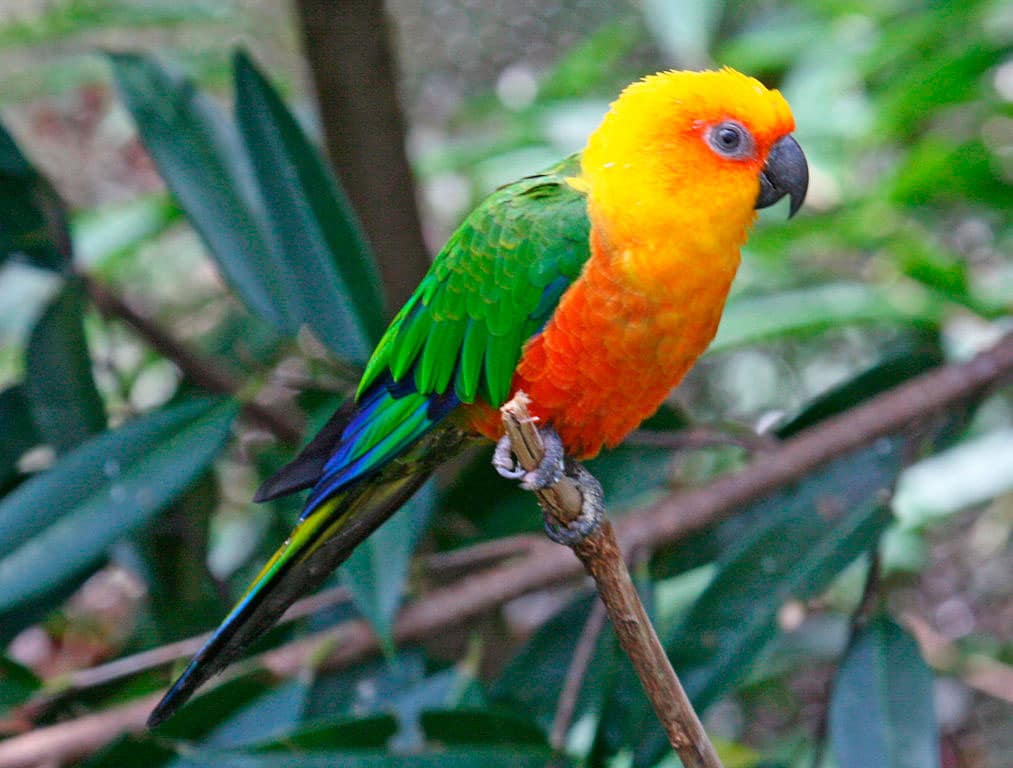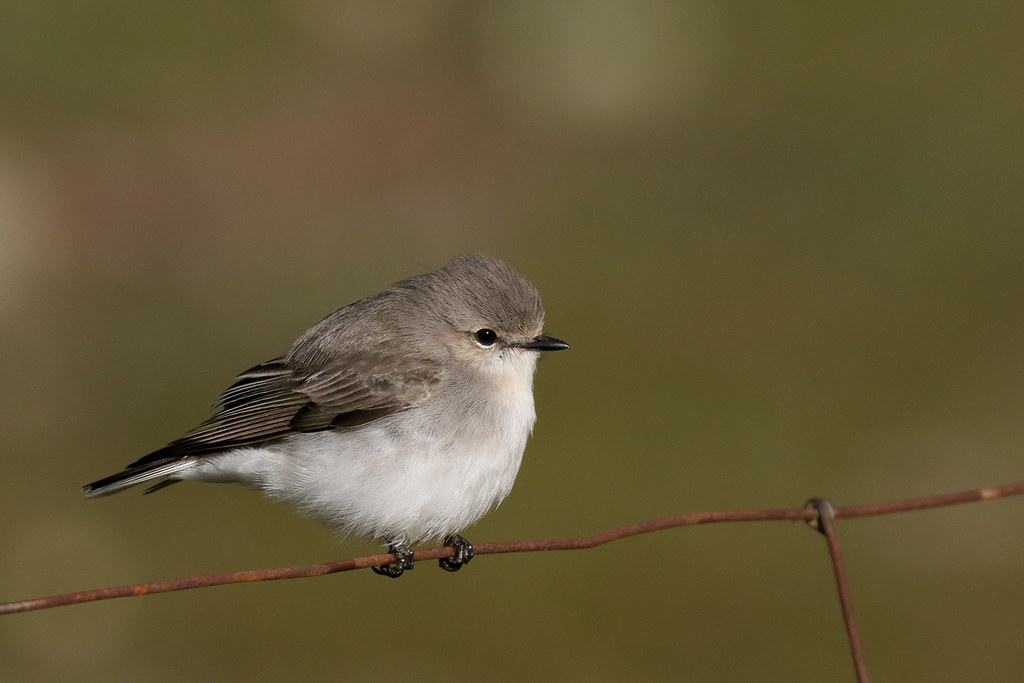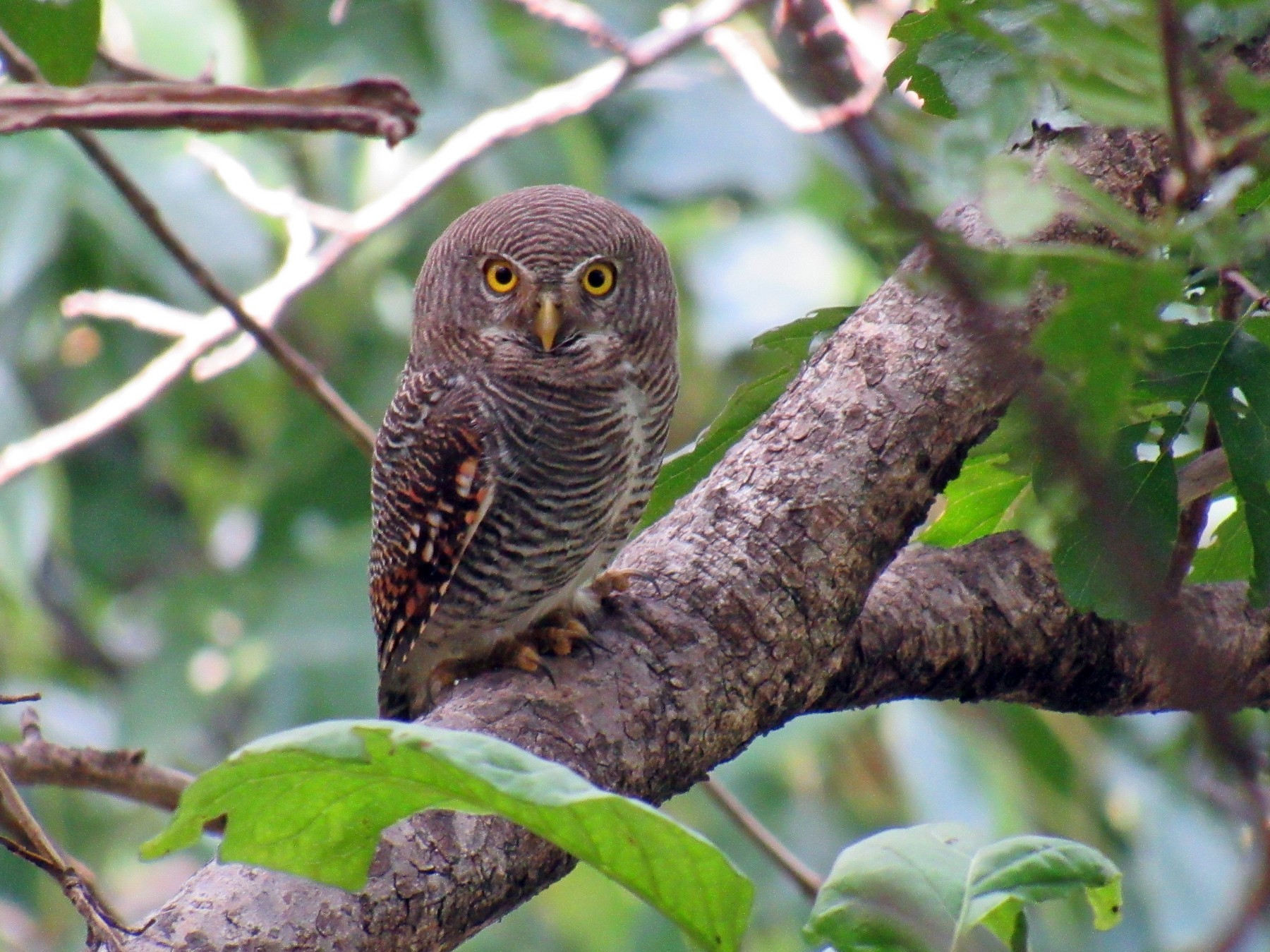I am an avid birdwatcher. As you might suspect, that means that I am always on the lookout for new birds at my feeders, in trees near my house, and whenever I travel. There’s a certain kind of magic about birds, and it can be hard to put your finger on why this is. Maybe it’s their extravagant plumage, perhaps it’s their soothing song, or maybe it’s simply that they fly into our lives and awaken the adventurer in us all. In this post, you’ll find a list of birds that start with the letter J. Peruse them and feel a growing sense of wonder.
Jamaican Crow (Corvus jamaicensis)
The Jamaican Crows are a small grey crow species known for their dull-colored plumage. These corvids are abundantly found in the hilly country area with middle elevation in Jamaica.
Jamaican crows have a very distinctive look; you can find them in dry forests as well as in wet limestone forests. They also have a unique nasal call that makes it easy for anyone to identify them.
Morphologically, these species share similar features to the Cuban and White-necked Crows, both of which are West Indian species.
Jabiru (Jabiru mycteria)

The Jabirus are a tall, American stork species well-known for their distinctive swollen neck appearance.
Within the United States, these birds can be found in the state of Texas, mainly in the Mississippi region in some specific seasons.
Jabirus have a large, gunmetal-colored bill with a black head and neck. At the base of their neck, they have a red, stretchable pouch. The rest of their plumage is mainly white. Both sexes have identical plumage; only the males are significantly larger in size.
Jabirus survive by hunting fish, amphibians, and mollusks near ponds and rivers.
Jamaican Owl (Asio grammaticus)
The Jamaican Owls are medium-to-large-sized nocturnal owls. These owls are mostly found in gardens and parks, usually settling their nest in tree cavities.
Jamaican Owls are easily distinctive due to their long ear tufts and hazel eyes with a black-rimmed, amber facial disk. They mainly feed on amphibians, spiders, birds, lizards, and other large insects.
Jamaican Owls have a widespread population within a small region of Jamaica, where you can easily find their eggs in the tree hollows.
James’s Flamingo (Phoenicoparrus jamesi)

James’s Flamingos are an American flamingo species named after Harry Berkeley James. These birds are also referred to as “Puna Flamingos.” They’re found in Chile, Peru, Northwest Argentina, and Bolivia.
James’s Flamingos are about as large as their Old World relatives, Lesser Flamingos. They have a white head and body, with touches of pink on their face and breast, as well as pink plumes on their back. Their bill is primarily black, with a round, yellow spot on it.
Interestingly enough, the baby James’s Flamingos feed on esophageal secretion from their parents, which is regurgitated from their crop.
Jamaican Woodpecker (Melanerpes radiolatus)
Jamaican Woodpeckers, from the Picidae family, are a bird species popular all over Jamaica. The locals simply refer to these birds as “Woodpeckers.”
These woodpeckers inhabit the tropical and subtropical region of degraded forests. You can also find them in the lowland forests occasionally.
Their distinctive properties are a white head with a vibrant red nape. Their breast and underparts are yellowish-brown in color. Both sexes look like; only the females have a smaller red patch on their heads.
Jackson’s Hornbill (Tockus jacksoni)
Jackson’s Hornbills are a well-known and populated hornbill species mainly found in northeast Uganda as well as northwest Kenya.
Some consider these birds as the subspecies of Von der Decken’s Hornbill due to their similar appearance, but they have dense white spots in their wing coverts, which sets the two apart.
Jackson’s Hornbills are medium-sized hornbills that survive in the dry savannahs by flocking in large groups. You can distinguish between their sexes using their bill; while the males have yellow-tipped bills, the bills of their female counterparts are black.
Javan Hawk-eagle (Spizaetus bartelsi)
The Javan Hawk-Eagles are an endangered species of the Accipitridae family that are widely popular for their medium-sized appearance with a dark brown plumage.
These birds have a rufous head and neck with heavily barred underparts. They also have a dark, white-tipped crest on their heads, which is held vertically and looks remarkable.
Their wings are dark brown with a fading brown tail, along which several cream stripes run. Both sexes of Javan Hawk-eagles harbor a similar plumage.
Jambu Fruit Dove (Ptilinopus jambu)

Commonly found in southern Thailand, Malaysia, Brunei, Indonesia, and Sumatra, the Jambu Fruit Doves are a small and colorful fruit dove species.
These birds inhabit the mangroves, swamps, and rain forests. The males of their species are highly territorial and protect their territory by bobbing their bodies and raising their wings.
Jambu Fruit Doves have a small, red-colored head and white underparts. Their back, wings, and tails are all colored in bright green. You can distinguish their sex by their face; the females have a dull, purple face instead of the males’ bright red ones.
Jacobin Cuckoo (Clamator jacobinus)
Jacobin Cuckoos are an Asian cuckoo species widely distributed across Saharan Africa, India, and Sri Lanka.
Jacobin cuckoos are tiny and slim-bodied, with a distinctive black crest resting atop their heads. While their underparts are white, the head and back are covered completely in black. There is scarce data about their sexual dimorphism.
They have a sharp, ringing calling sound that goes “piu-piu.” Their diet mainly consists of insects, particularly grasshoppers.
Javan Kingfisher (Halcyon cyanoventris)

Commonly found on the islands of Java and Bali, the Javan Kingfishers are an Indonesian kingfisher species that are also known as “Blue-bellied Kingfisher.”
These birds are small, with a comparatively large head and bill. Their eyes, head, nape, and throat are dark brown, with a contrasting red bill. The rest of their body is covered in shades of blue and purple.
Javan Kingfishers are not suited for aquatic hunting and prefer to catch their prey on the land or near the water edge.
Japanese Robin (Larvivora akahige)

Also referred to as “Komadori,” the Japanese Robins are members of the Old World Flycatcher family endemic to Japan. They have a widespread population on the islands of Sakhalin and Kuril. These birds are migratory and can be spotted in parks and gardens in winters.
Japanese Robins are small songbirds with an orange head and throat, with dull brown upperparts. Their underparts are mainly dark brown in color. Not much is known about the sexual dimorphism found in adults.
Jamaican Blackbird (Nesopsar nigerrimus)

Jamaican Blackbirds are an endangered blackbird species of the icterid family that inhabit the higher elevation woodlands in Jamaica. Unlike the other blackbird species, they can also reside in forest canopies.
The plumage of Jamaican Blackbirds is entirely black, coupled with a short, flayed tail and a long, slim bill. There isn’t much information about their sexual dimorphism.
Charcoal production, forestry, and bauxite mining are activities that are the main threats to their population.
Japanese Night-heron (Gorsachius goisagi)
The Japanese Night Herons are a vulnerable Asian heron species that primarily inhabit the damp forests within their range. These herons are migratory; they breed in Japan and travel south to Indonesia and the Philippines during winters.
Japanese Night-herons have a mostly rusty brown body with darker wings. They have a small bill and dull golden eye-rings. They’re crepuscular and actively hunt for food in large groups during twilight.
The population of Japanese Night-herons is threatened by habitat loss due to the large-scale deforestation of urban and rural forests.
Jandaya Parakeet (Aratinga jandaya)

Also referred to as “Jenday Conures,” the Jandaya Parakeets are members of the New World Parrot family that are native to Brazil. They’re popularly used in the practices of Aviculture.
Jandaya Parakeets have a small body with a relatively long tail. Their heads and undersides are a bright mixture of red and orange, with green wings and a blue-tipped tail.
Although these parrots enjoy eating nuts and seeds, you can also feed the fresh fruits and veggies in moderation.
Javan Green Magpie (Cissa thalassina)
The Javan Green Magpies are an inquisitive Indonesian corvid species that are well-known for their intelligence. The IUCN has listed them as a Critically Endangered Species; their declining population is sensitive to natural habitat loss and illegal capturing.
Javan Green Magpies closely resemble the crows in appearance but have a more colorful plumage. These magpies have a green head and underbody with a red bill and black eye mask.
The green plumage of these magpies is a result of their insect-based diet. The adults living in captivity might grow bluish if they don’t consume an appropriate diet.
Japanese Pygmy Woodpecker (Yungipicus kizuki)

The Japanese Pygmy Woodpeckers are a Eurasian woodpecker species that are quite flexible about their habitat. They can be found in deciduous, coniferous, riverine, upland, and lowland forests. These woodpeckers are resident species inhabiting Japan, Russia, Korea, and China.
Japanese Pygmy Woodpeckers are small birds and have a grey-brown colored crown, brown ear coverts, and white mustache stripe. The red patch on their nape can be used to differentiate the sexes; only the males have it.
Javan Pond Heron (Ardeola speciosa)

Popular throughout Southeast Asia, the Javan Pond Herons are large wading birds that inhabit shallow freshwater and saltwater wetlands.
These herons have a medium-sized body with a pale-yellow bill with a black tip. Their plumage is primarily white, with a touch of buff-brown on their crown, extending down to their throat.
During the breeding seasons, you can notice slate-colored plumes on their lower back. Both adult sexes appear similar and display negligible sexual dimorphism.
Japanese Waxwing (Bombycilla japonica)

The Japanese Waxwings are a near-threatened waxwings species found in Eurasia.
These birds have pinkish-brown plumage, a black throat, a pale-yellow belly, and a black stripe going through the eyes. However, they don’t have the waxy red feather tips, which sets them apart from the other waxwing species.
Although Japanese Waxwings do not produce any true song, they do have a high-pitched, trill-like call.
Java Sparrow (Padda oryzivora)
The Java Sparrows are an Indonesian sparrow species that have received an endangered species status by the IUCN. These birds are also referred to as “Java Rice Birds,” “Java Rice Sparrows,” and “Java Finches.”
Within Indonesia, you are most likely to spot these little birdies on the islands of Bali and Java. They’re also popular as cage birds, which is how they’re introduced to other countries as well.
Javan Sparrows are similar in size to the House Sparrows and have a grey breast and upper parts. Their heads are black, save for two bold white cheek patches. They also have a pale orangish bill and red eye-rings.
While their flight feathers are grey, the tail is contrastingly black. Both sexes of adults have similar plumage and display little sexual dimorphism.
Japanese Tit (Parus minor)

The Japanese Tits are a Eurasian tit species; initially considered a subspecies of the Great Tits but are now declared a separate species.
These are small birds that have a black head with two white cheek patches. Their back is olive green with a greyish edge to their wings and tail. Their underparts are buff-colored, with dark eyes and a short, dark bill.
Junin Grebe (Podiceps taczanowskii)
The Junin Grebes are an endangered aquatic bird species that have been named after their nativity to Lake Junin in Peru.
These grebes are medium-sized bodies, with the upper part of their head covered in dark grey and the lower part being white. This white extends to their neck, below which their underbody is a lighter grey. The red eyes of these grebes are an important field identification mark.
Japanese Wood Pigeon (Columba janthina)
Japanese Wood Pigeons are a near-threatened Asian pigeon species. These birds are considered to be the largest members of their genus. They primarily inhabit tropical lowland and temperate forests.
The steady decline in their population is attributed to deforestation and hunting. They have three subspecies, with each one displaying minor differences in plumage.
Japanese Wood Pigeons have a small head, a long neck, a stout body, and a fan-shaped tail. They have a sooty black body with green iridescence, except their neck, which is of a paler shade.
Javan Flameback (Chrysocolaptes strictus)
The Javan Flamebacks are an Indonesian woodpecker species that are common inhabitants on the islands of Kangean, Bali, and Java. Many birders consider these birds to be a subspecies to the Greater Flamebacks, although they aren’t.
The IUCN has included these woodpeckers in the Vulnerable Species List due to their declining population because of deforestation and habitat loss.
Javan Flamebacks have olive-colored wings, a bright red crest, with the remaining parts of their body covered in black and white. Although it has not been confirmed yet, it is likely that only the males have the red crest and not their female counterparts.
Japanese Cormorant (Phalacrocorax capillatus)
Inhabiting the east Palearctic regions, the Japanese Cormorants are a large cormorant species that are found in abundance in Japan.
These cormorants are also referred to as “Temminck’s Cormorant.” They have an entirely black body, except for white cheeks and throat. Their bills are also partially yellow. The ornithologists have no solid evidence of their sexual dimorphism.
The Japanese, particularly their fishermen, can even domesticate these cormorants and use them to catch sweetfish or Ayu. In Japan, the term for it is “Ukai,” which means “raising a cormorant.”
Jungle Myna (Acridotheres fuscus)
Closely related to the Javan Mynas, the Jungle Mynas are members of the Starling family. These birds are a resident species and breed in southern Asia, from India to Indonesia, to be precise. In many parts of their range, they’re also kept as pets.
Javan Mynas are long-bodied birds that have an overall grey plumage. On their head and wings, they harbor dark touches. Their bill is black-based with orange tips, while their legs are also orange. These mynas also have bright yellow irises.
Jacky Winter (Microeca fascinans)

Named after their unique vocalizations, the Jacky Winters are small robin species found in Australia and Papua New Guinea. These birds commonly inhabit farmlands and open woodlands.
Jacky Winters have a dark grey head and plumage, with pale white underparts. On their wings and tail, you can notice a prominent white edge.
These robins are primarily insectivores and feed mostly on flying insects. Their call is rapid and strong, sounding something like “jacky-jacky-winter-winter.”
Japanese Sparrowhawk (Accipiter gularis)
The Japanese Sparrowhawks are an Asian, migratory raptor species that have a widespread population in Siberia, Korea, Japan, and China during summers. During winters, they travel south to the Philippines and Indonesia.
Japanese Sparrowhawks have bright blue plumage with a touch of grey. Their upper parts are darker than their undersides. The adults of both sexes appear the same in plumage, but the females are larger in size.
Jungle Owlet (Glaucidium radiatum)
Also referred to as “Barred Jungle Owlet,” the Jungle Owlets are a round-headed owl species found in the Indian subcontinent. These owls are crepuscular in nature; you can hear their calls during dusk and dawn.
Jungle Owlets are common inhabitants in the moist deciduous and scrub forests. Their diet consists mostly of insects and smaller birds.
Jungle Owlets have no definitive facial mask; they’re rather round-headed. They have entirely brown plumage with barring all over. Their underparts are lighter than their upper body.
Japanese Bush Warbler (Horornis diphone)

The Japanese Bush Warbler is an Asian warbler species that is commonly found throughout Japan. In Japanese, they are called “Uguisu.”
These warblers are extremely tiny and have a pale olive-colored head and upperparts, with slightly paler undersides. There is very little data about the sexual dimorphism between the sexes.
Conclusion: Birds That Start With J
You know, I’ve spent a lot of time on this article and this is the end result. I hope that you’ll appreciate all of my hard work, but if not it’s okay :). As always, I am more than happy to answer any questions you may have. If you like this article, please share it with your friends 🙂
It is amazing how many different kinds of birds there are just in our country, let alone the world! But it’s not only breathtaking to think about how many different kinds of creatures there are, but also how they can vary so much from one another. And speaking of variation, no one bird is exactly like any other. Each has its own unique features and characteristic behaviors. From their feathers to their flying style to their remarkable songs, birds are featured in some of nature’s greatest designs.
One final parting observation: These birds are beautiful.
Birds By Alphabet (A-Z List)
Birds that Start with A
Birds that Start with B
Birds that Start with C
Birds that Start with D
Birds that Start with E
Birds that Start with F
Birds that Start with G
Birds that Start with H
Birds that Start with I
Birds that Start with J
Birds that Start with K
Birds that Start with L
Birds that Start with M
Birds that Start with N
Birds that Start with O
Birds that Start with P
Birds that Start with Q
Birds that Start with R
Birds that Start with S
Birds that Start with T
Birds that Start with U
Birds that Start with V
Birds that Start with W
Birds that Start with X
Birds that Start with Y
Birds that Start with Z















